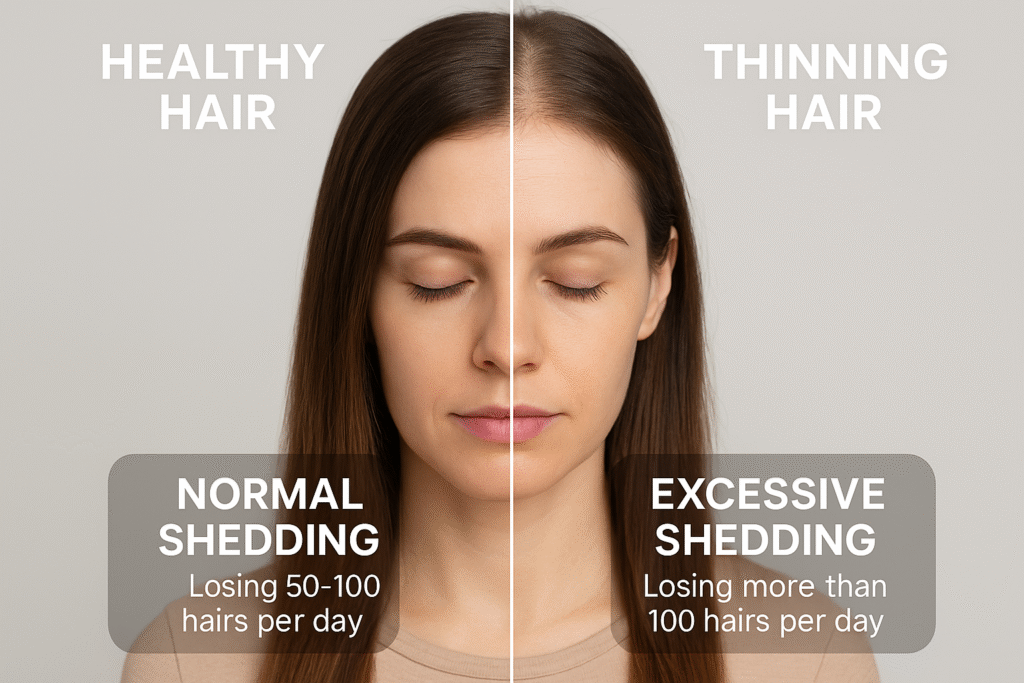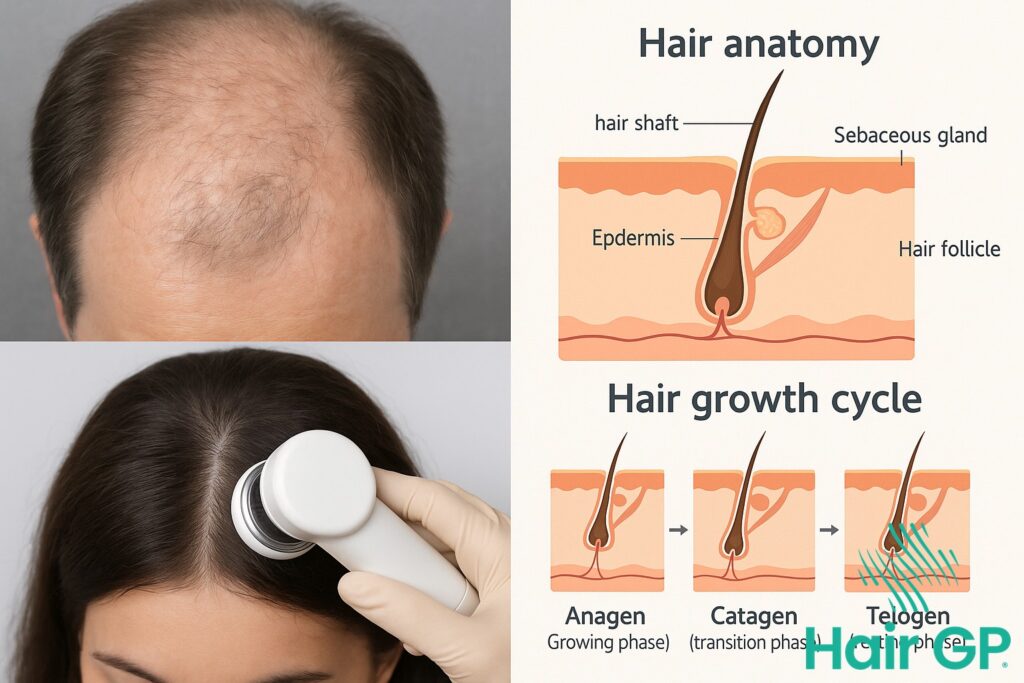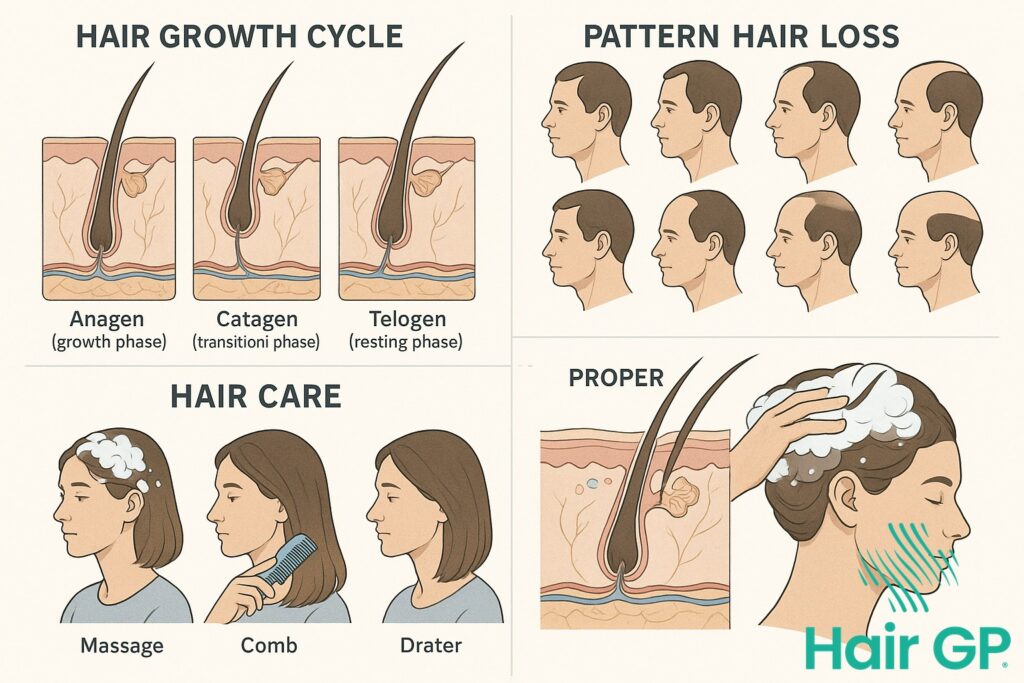Introduction
Discovering extra hair in your brush or on your pillow can trigger immediate concern about potential hair loss. However, distinguishing between normal hair shedding and actual hair thinning is crucial for understanding whether you need to take action or simply embrace a natural biological process.
Every day, it’s completely normal to lose between 50-100 hairs as part of your hair’s natural growth cycle. This normal shedding occurs as older hairs complete their lifecycle and make room for new growth. Yet when hair shedding becomes excessive or when thinning hair becomes noticeable, it may signal underlying issues that require attention.
The key lies in understanding the fundamental differences between these two processes. Hair shedding typically involves temporary hair loss that eventually regrows, while hair thinning often indicates progressive loss where hair follicles may gradually produce thinner, weaker strands or stop producing hair entirely.
This comprehensive guide will help you navigate this common concern by explaining the natural hair growth process and what constitutes normal shedding patterns. You’ll learn to identify the telltale signs of genuine hair thinning, understand the various factors that can trigger excessive hair loss, and discover practical methods for monitoring your hair’s condition at home.
We’ll also explore when it’s time to consult a hair specialist, what professional evaluation involves, and the range of treatment options available. Whether you’re experiencing stress-related shedding or genetic hair thinning, understanding these distinctions empowers you to make informed decisions about your hair health and take appropriate action when necessary.
Key Takeaways
- Normal hair shedding involves 50-100 hairs daily as part of the natural hair growth cycle
- Hair thinning shows gradual density reduction with shorter, finer regrowth over time
- Shedding is temporary while thinning indicates permanent follicle changes requiring intervention
- Professional assessment is crucial when experiencing sudden changes or persistent hair loss
Understanding Normal Hair Shedding and the Hair Growth Cycle
Understanding the natural hair growth cycle is essential for distinguishing between normal hair shedding and potential hair loss concerns. The hair growth cycle consists of three distinct phases that regulate how hair follicles produce, maintain, and eventually shed hair strands as part of a healthy biological process.
The Three Phases of Hair Growth
The natural hair growth cycle operates through three sequential phases that determine the lifespan and characteristics of each hair strand. The anagen phase represents the active growth period, during which hair follicles produce new hair continuously for approximately 2-7 years [1]. This extended growth phase explains why scalp hair can achieve significant length before naturally shedding. Following anagen, hair enters the catagen phase, a brief transitional period lasting 2-3 weeks where growth stops and the hair follicle begins to shrink [1]. Finally, the telogen phase serves as the resting period, lasting 2-3 months, during which the hair remains attached but no longer grows before eventually shedding to make room for new growth [1].
At any given time, approximately 85-90% of hair follicles exist in the anagen phase, while 10-15% rest in the telogen phase. This distribution ensures continuous hair coverage while allowing for natural renewal through the hair growth cycle. The synchronized nature of this process means that hair shedding occurs gradually and consistently rather than in dramatic episodes.
What Constitutes Normal Daily Hair Shedding
Normal hair shedding ranges from 50-100 hairs daily, representing the natural conclusion of individual hair growth cycles [2]. This range accounts for variations in hair density, age, and individual genetic factors that influence the hair growth cycle timing. People with thicker hair or higher follicle density may experience shedding toward the upper end of this range while maintaining healthy hair coverage.
Several factors make normal hair shedding more noticeable during daily activities. Hair washing tends to concentrate several days’ worth of loose telogen phase (shedding) hairs into a single event, creating the impression of excessive shedding. Similarly, brushing or styling can dislodge hairs that were already prepared to shed naturally. Understanding these patterns helps distinguish between normal hair shedding and concerning hair loss, as consistent daily amounts within the 50-100 range indicate healthy hair follicle function and natural hair growth cycle progression.
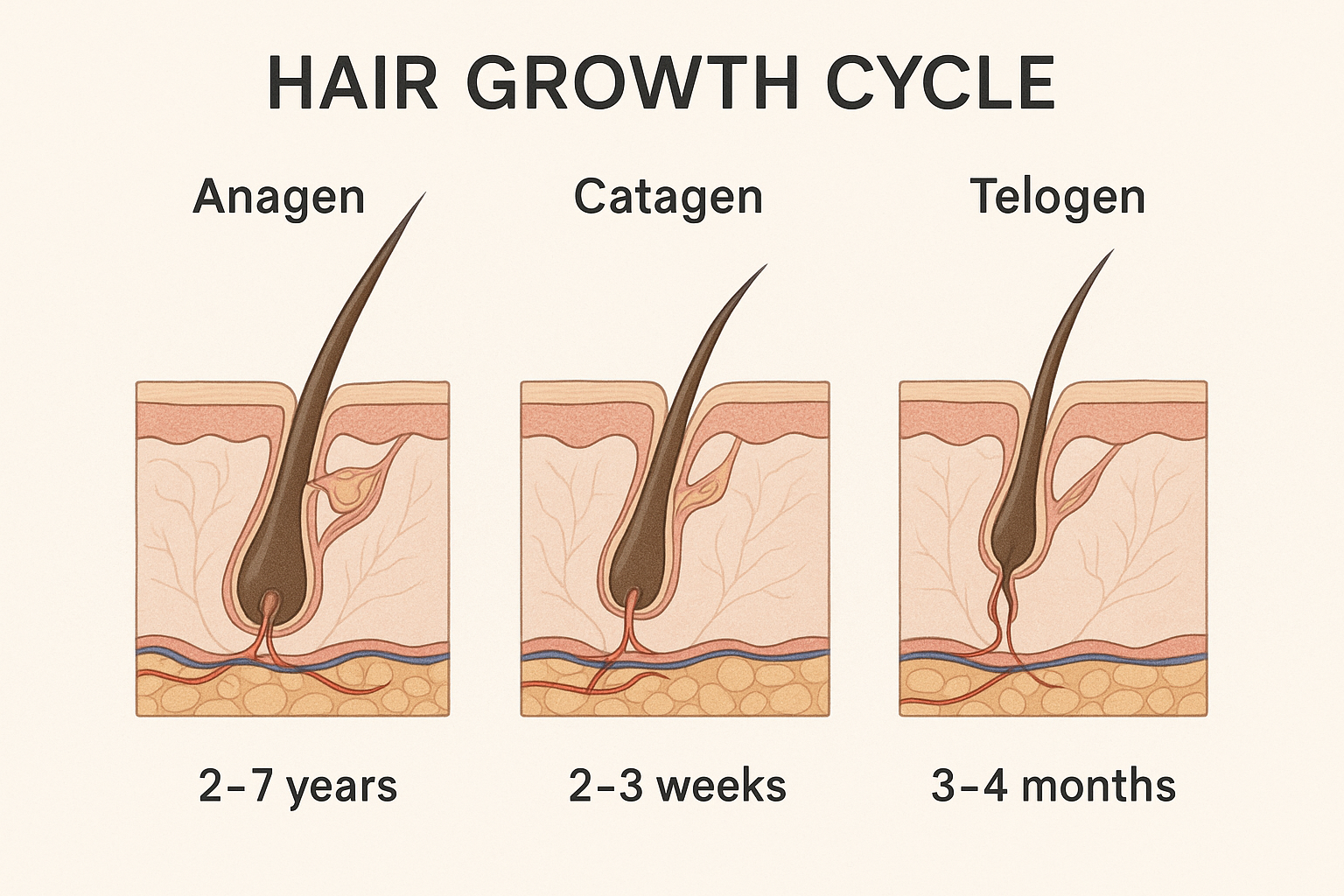
Recognizing the Signs of Hair Thinning
Identifying genuine hair thinning requires careful observation of specific visual and physical changes that extend beyond normal daily shedding. While losing 50-100 hairs daily is natural, recognizing the distinct signs of actual hair thinning helps determine when professional intervention may be beneficial.
Visual Changes in Hair Density and Scalp Visibility
The most noticeable indicator of thinning hair involves increased scalp visibility through your existing hair coverage. When hair density decreases, the scalp becomes more prominent, particularly under bright lighting or when hair is wet. Clinical studies show that scalp visibility increases significantly when hair density drops below 200 hairs per square centimeter [3]. Pay attention to areas where you can see more scalp than previously, especially at the crown or along your hairline.
Another reliable indicator involves measuring your ponytail thickness if you regularly wear your hair tied back. Gradual thinning often becomes apparent when your ponytail feels noticeably thinner or requires additional loops of your hair elastic to secure properly. The circumference reduction reflects overall hair density loss rather than just length changes.
Wider hair parts represent another clear sign of hair thinning. If your natural part appears broader than before, or if you notice new areas where the scalp shows through when styling your hair, this indicates reduced hair density in those regions. A receding hairline typically begins with subtle changes at the temples before progressing to more obvious recession patterns.
Changes in Hair Texture and Quality
Hair thinning often involves a process called miniaturization, where individual hair strands become progressively finer and shorter over time. Research on androgenetic alopecia patterns demonstrates that affected hairs gradually decrease in diameter and length before eventually stopping growth entirely [4]. You might notice that your hair feels less substantial when running your fingers through it, or that individual strands appear more delicate than before.
The texture changes extend beyond simple fineness. Thinning hair often becomes more fragile, breaking more easily during brushing or styling. You may observe that your hair doesn’t hold styles as well as previously, appearing limp or lacking its former volume and body.
Additionally, affected hairs tend to grow to shorter maximum lengths before naturally shedding. If you notice that your hair seems unable to grow past a certain length that was previously achievable, this suggests the growth phase of your hair cycle has shortened due to gradual thinning processes.
Recognizing these specific signs enables you to distinguish between temporary hair changes and genuine thinning patterns that may benefit from professional evaluation and targeted treatment approaches.
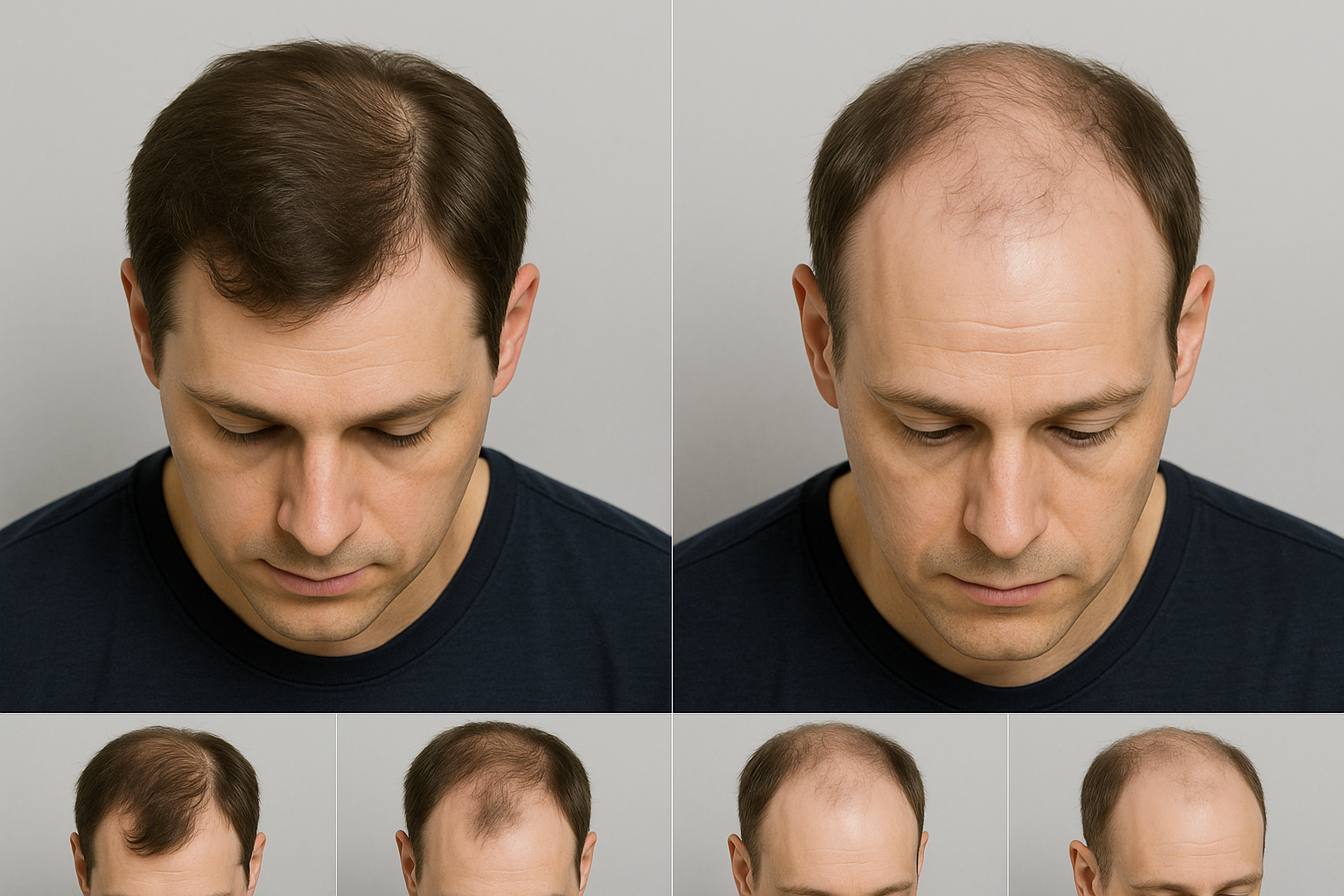
Key Differences Between Hair Shedding and Hair Thinning
Understanding the distinction between hair shedding and hair thinning represents a crucial step in addressing hair concerns effectively. While both conditions involve hair loss, they differ fundamentally in their underlying mechanisms, reversibility, and long-term implications. Hair shedding typically refers to the temporary acceleration of the natural hair cycle, where more follicles enter the telogen phase simultaneously, resulting in increased daily hair fall. In contrast, hair thinning involves the progressive miniaturization of hair follicles, leading to actual hair loss where follicles gradually produce thinner, weaker strands before potentially ceasing production entirely.
The most significant difference lies in regrowth patterns and reversibility. Normal shedding, even when excessive hair shedding occurs due to stress, hormonal changes, or nutritional deficiencies, maintains the integrity of hair follicles. These follicles remain capable of producing new hair once the triggering factor resolves, typically resulting in complete recovery within 6-12 months. Hair thinning, however, involves permanent structural changes to follicles, where the anagen phase progressively shortens and the follicle diameter decreases with each growth cycle. This process is largely irreversible without intervention, as the follicle’s capacity to produce terminal hairs becomes permanently compromised.
Hair quality characteristics provide additional distinguishing factors between these conditions. During episodes of hair shedding, the shed hairs typically maintain their original diameter and length, appearing healthy despite increased volume. The remaining hair on the scalp retains its normal texture, color, and strength. Conversely, hair thinning produces noticeable changes in hair quality, with new growth appearing progressively finer, shorter, and lighter in color. The hair shaft diameter decreases significantly, and the overall density reduction becomes visually apparent as the scalp becomes more visible through the remaining hair.
Timeline differences offer another critical diagnostic criterion. Hair shedding episodes typically follow identifiable triggers by 2-4 months, reflecting the natural delay between stressor occurrence and telogen phase entry. These episodes usually resolve within 6-12 months once the underlying cause addresses itself. Hair thinning follows a more gradual, insidious timeline, often developing over years without obvious triggers. The progressive nature means that by the time thinning becomes noticeable, significant follicular damage may have already occurred, emphasizing the importance of early recognition and appropriate response strategies.

Common Causes of Excessive Hair Shedding
Excessive hair shedding often results from temporary disruptions to the normal hair growth cycle, a condition medically known as telogen effluvium. This reversible form of temporary hair loss affects approximately 30% of women at some point in their lives and occurs when various stressors push hair follicles into the resting phase prematurely [5]. Understanding these triggers helps individuals identify the root cause of their hair shedding and take appropriate corrective measures.
Emotional and physical stress represent the most common culprits behind sudden hair shedding episodes. Research demonstrates that both acute and chronic stress can trigger telogen effluvium by disrupting the hypothalamic-pituitary-adrenal axis, which directly affects hair follicle cycling [1]. Major life events such as job loss, divorce, illness, or surgery often precede severe shedding episodes by two to three months, reflecting the delayed nature of this condition.
Hormonal fluctuations frequently trigger temporary hair loss, particularly in women experiencing pregnancy, postpartum recovery, menopause, or thyroid disorders. The dramatic hormonal shifts during these periods can cause widespread follicle disruption, leading to diffuse hair shedding that typically resolves once hormone levels stabilize.
Nutritional deficiencies create another significant category of shedding triggers. Iron deficiency, protein malnutrition, and inadequate intake of vitamins D, B12, and zinc can all precipitate telogen effluvium. Crash diets, eating disorders, and malabsorption conditions often contribute to these deficiency-related shedding episodes.
Certain medications commonly cause temporary hair loss as a side effect. Blood thinners, antidepressants, beta-blockers, retinoids, and some antibiotics can trigger excessive hair shedding in susceptible individuals. Additionally, medical conditions such as autoimmune diseases, severe infections, high fevers, and chronic illnesses can disrupt normal hair growth patterns. The encouraging aspect of telogen effluvium is its reversible nature – once the underlying trigger is identified and addressed, normal hair growth typically resumes within six to twelve months, though full density recovery may take longer depending on the severity and duration of the triggering factor.
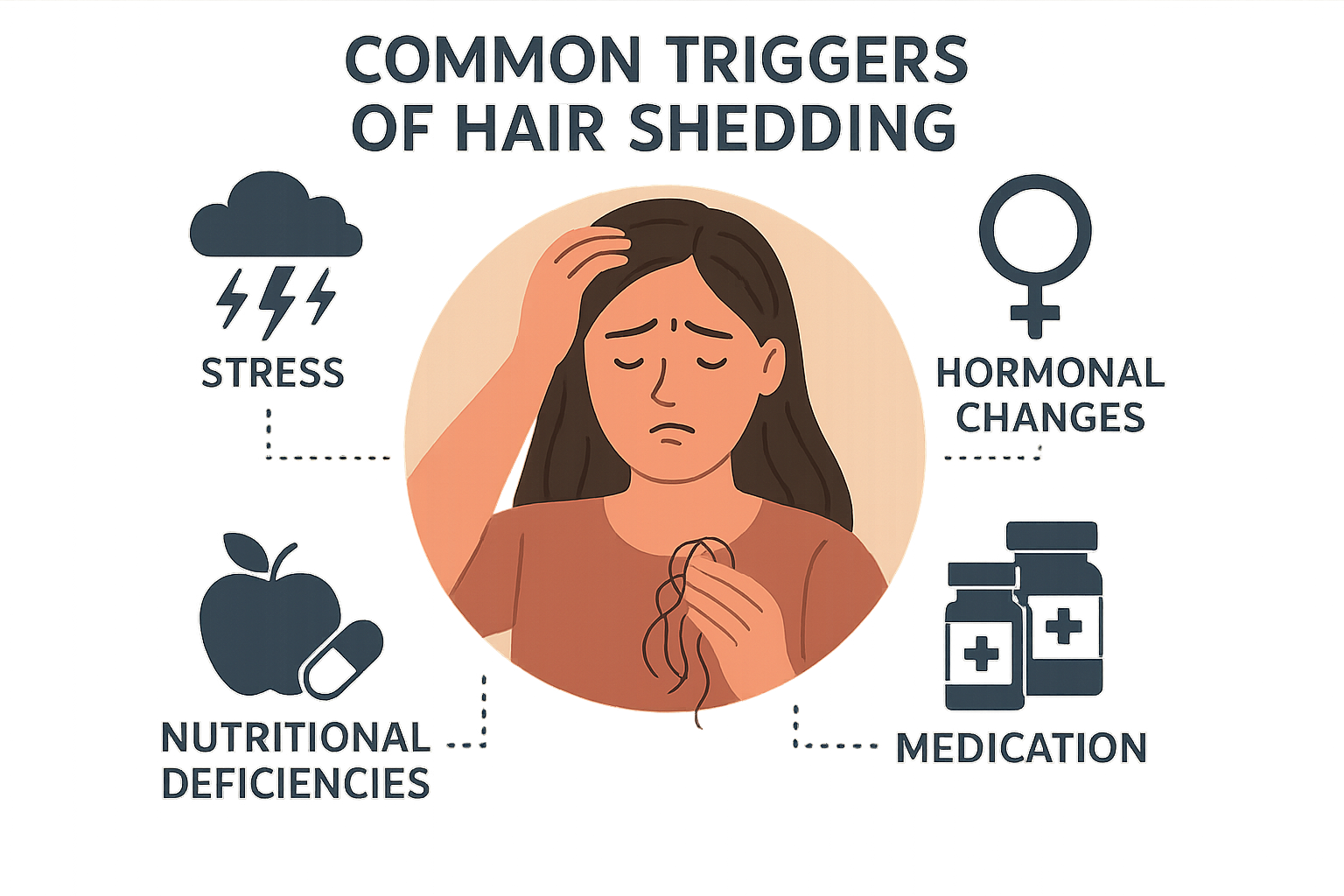
Understanding Hair Thinning and Balding Causes
Hair thinning and balding represent complex processes involving genetic predisposition, hormonal influences, and various medical conditions that cause progressive follicular miniaturization and permanent hair loss. Unlike temporary shedding patterns, these conditions involve irreversible changes to hair follicle structure and function, leading to decreased hair density and eventual balding in affected areas.
Androgenetic Alopecia and Pattern Hair Loss
Androgenetic alopecia stands as the predominant cause of hair thinning, affecting approximately 95% of men and 40% of women by age 50 [6]. This hereditary hair loss condition results from genetic susceptibility to dihydrotestosterone (DHT), a potent androgen hormone derived from testosterone through 5-alpha-reductase enzyme conversion. In genetically predisposed individuals, DHT binds to androgen receptors in hair follicles, triggering a progressive miniaturization process that shortens anagen phases and reduces follicle size.
Male pattern hair loss typically manifests as recession at the temples and crown thinning, following predictable patterns classified by the Norwood-Hamilton scale. The genetic component involves multiple polymorphisms, with the androgen receptor gene on the X chromosome playing a crucial role [7]. Female pattern hair loss presents differently, characterized by diffuse thinning across the central scalp while maintaining the frontal hairline. This androgenic alopecia in women often correlates with hormonal fluctuations during menopause, pregnancy, or conditions like polycystic ovary syndrome.
The progressive nature of androgenetic alopecia involves three distinct phases: initial follicular sensitivity to DHT, gradual miniaturization over multiple hair cycles, and eventual follicular atrophy. This process transforms terminal hairs into vellus-like hairs before follicles become dormant, explaining why early intervention proves most effective in treatment protocols.
Other Medical Conditions Causing Hair Thinning
Alopecia areata represents an autoimmune condition causing patchy hair loss through T-cell mediated attacks on hair follicles during anagen phase. This condition affects approximately 2% of the population and can progress from small circular patches to complete scalp hair loss (alopecia totalis) or total body hair loss (alopecia universalis).
Thyroid disorders significantly impact hair growth cycles, with both hyperthyroidism and hypothyroidism causing diffuse hair thinning. Thyroid hormones regulate follicular metabolism, and imbalances disrupt normal growth patterns, leading to increased telogen effluvium and reduced hair density. Additional autoimmune conditions like lupus and inflammatory disorders can cause scarring alopecia, permanently destroying follicular structures and preventing regrowth in affected areas.
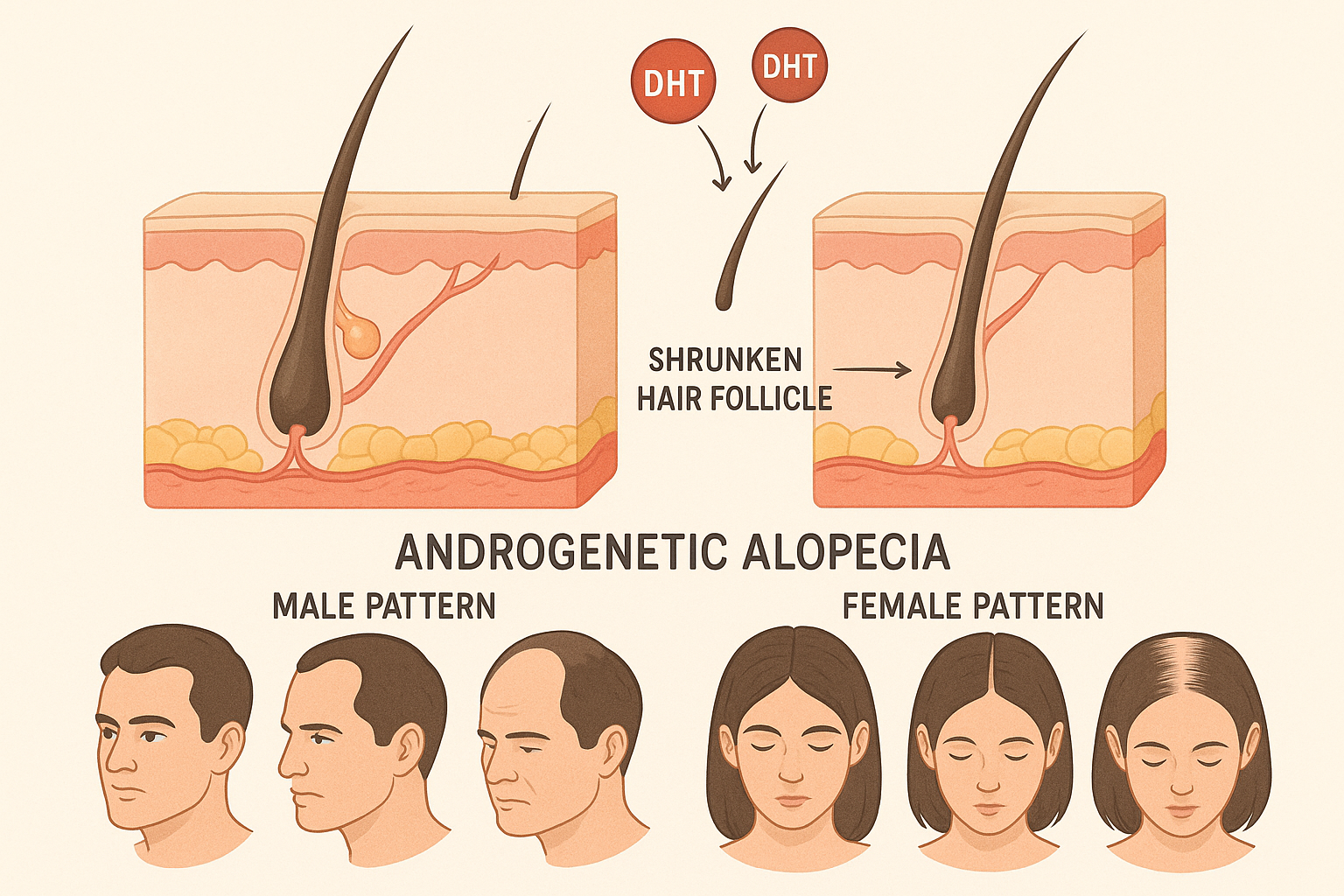
How to Assess Your Hair Loss at Home
When experiencing hair loss, objective assessment methods help distinguish between normal hair shedding and concerning patterns. Home evaluation techniques provide valuable baseline measurements and enable you to track changes over time, offering clear evidence of whether your hair falling concerns warrant further attention.
The Hair Pull Test and Daily Shedding Count
The hair pull test offers a simple way to assess active hair loss. Gently grasp a small section of about 60 hairs between your thumb and forefinger, starting near the scalp. Slowly pull along the hair shaft with steady pressure. Normal hair should yield fewer than six strands, while losing more than ten hairs may indicate excessive shedding. Perform this test on different scalp areas including the crown, temples, and back of the head for comprehensive assessment.
Daily shedding counts provide another valuable measurement tool. Collect all shed hairs from your pillow, shower drain, brush, and clothing throughout one complete day. Normal hair shedding ranges from 50 to 100 strands daily, though this varies based on hair density and length. Count hairs for several consecutive days to establish your baseline pattern, as daily variation is common.
Record your results in a simple log noting the date, pull test numbers, and daily shed counts. This documentation helps identify trends and triggers while providing concrete data if you later consult a healthcare provider about your hair concerns.
Tracking Changes with Photos and Measurements
Consistent photography documentation captures gradual changes that might otherwise go unnoticed. Take photos monthly using identical lighting, camera angles, and hair positioning. Focus on areas where you lose hair most noticeably, typically the crown, hairline, and part lines. Use natural lighting near a window and maintain the same distance from the camera for accurate comparisons.
Part your hair in the same location each month and measure the width using a ruler. Document measurements in millimeters for precision. Additionally, photograph your hairline from multiple angles, ensuring your hair is styled consistently each time to avoid misleading variations.
Create a simple tracking system combining photos, measurements, and notes about potential triggers like stress, illness, or medication changes. Monthly assessments provide sufficient frequency to detect significant changes without becoming obsessive. Store all documentation chronologically, either digitally or in a physical folder, creating a comprehensive record of your hair’s condition over time. This systematic approach transforms subjective concerns into objective data, enabling more informed decisions about your hair health.
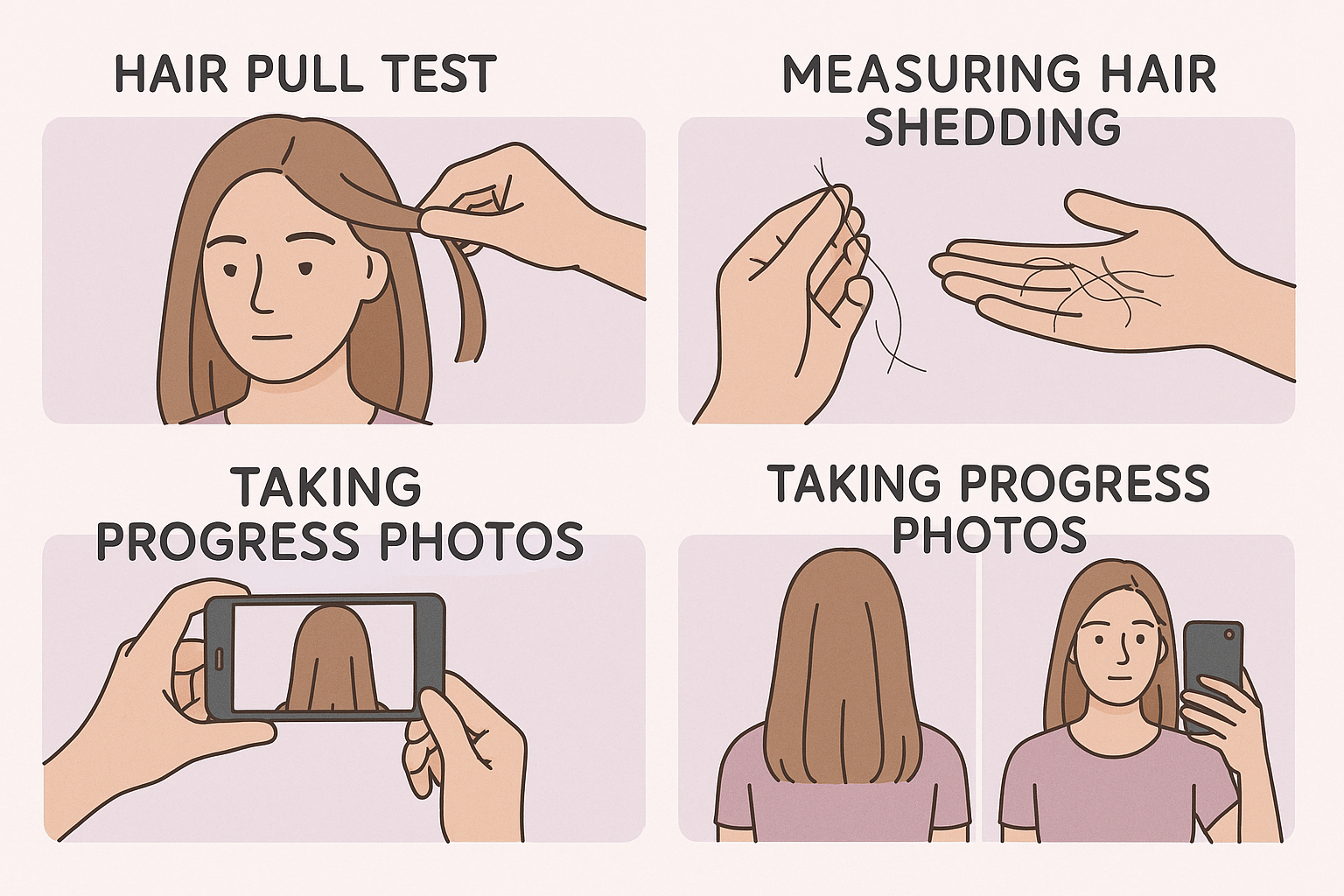
When to Consult a Hair Specialist or Dermatologist
Recognizing when to seek professional help for hair concerns can significantly impact treatment outcomes and prevent further hair loss. While mild seasonal shedding or temporary stress-related hair thinning may resolve naturally, certain symptoms warrant immediate consultation with a hair specialist or dermatologist. Understanding these warning signs ensures timely intervention when experiencing hair loss patterns that could indicate underlying medical conditions requiring specialized care.
Several red flags should prompt immediate professional evaluation. Sudden, rapid hair loss occurring over weeks rather than months may indicate alopecia areata, autoimmune conditions, or medication side effects requiring urgent attention. Scalp inflammation, including redness, scaling, burning sensations, or persistent itching, often signals dermatological conditions that can permanently damage hair follicles if left untreated. Hair loss accompanied by broken hairs, unusual patterns, or patches of complete baldness also necessitates professional assessment. Additionally, hair thinning that significantly impacts self-esteem or daily functioning merits specialist consultation regardless of severity.
Hair Consultation
During initial consultations, hair specialists conduct comprehensive evaluations beginning with detailed medical histories examining family genetics, recent illnesses, medications, stress levels, and dietary changes. Physical examinations involve careful scalp inspection using dermoscopy to assess follicle health, inflammation signs, and hair shaft abnormalities. Specialists evaluate hair distribution patterns, density measurements, and pull tests to determine shedding rates and hair strength.
Diagnostic Tools
Modern diagnostic tools provide precise assessments of scalp health and hair loss causes. Trichoscopy uses specialized cameras for magnified scalp visualization, revealing miniaturized follicles and early alopecia signs invisible to naked eyes. Blood tests may examine hormone levels, nutritional deficiencies, thyroid function, and autoimmune markers. In complex cases, scalp biopsies provide definitive diagnoses by examining follicle structures microscopically. Phototrichograms track hair growth rates and density changes over time, enabling specialists to monitor treatment progress accurately. These advanced diagnostic capabilities ensure accurate identification of hair loss causes, facilitating targeted treatment approaches that address specific underlying conditions rather than symptoms alone.
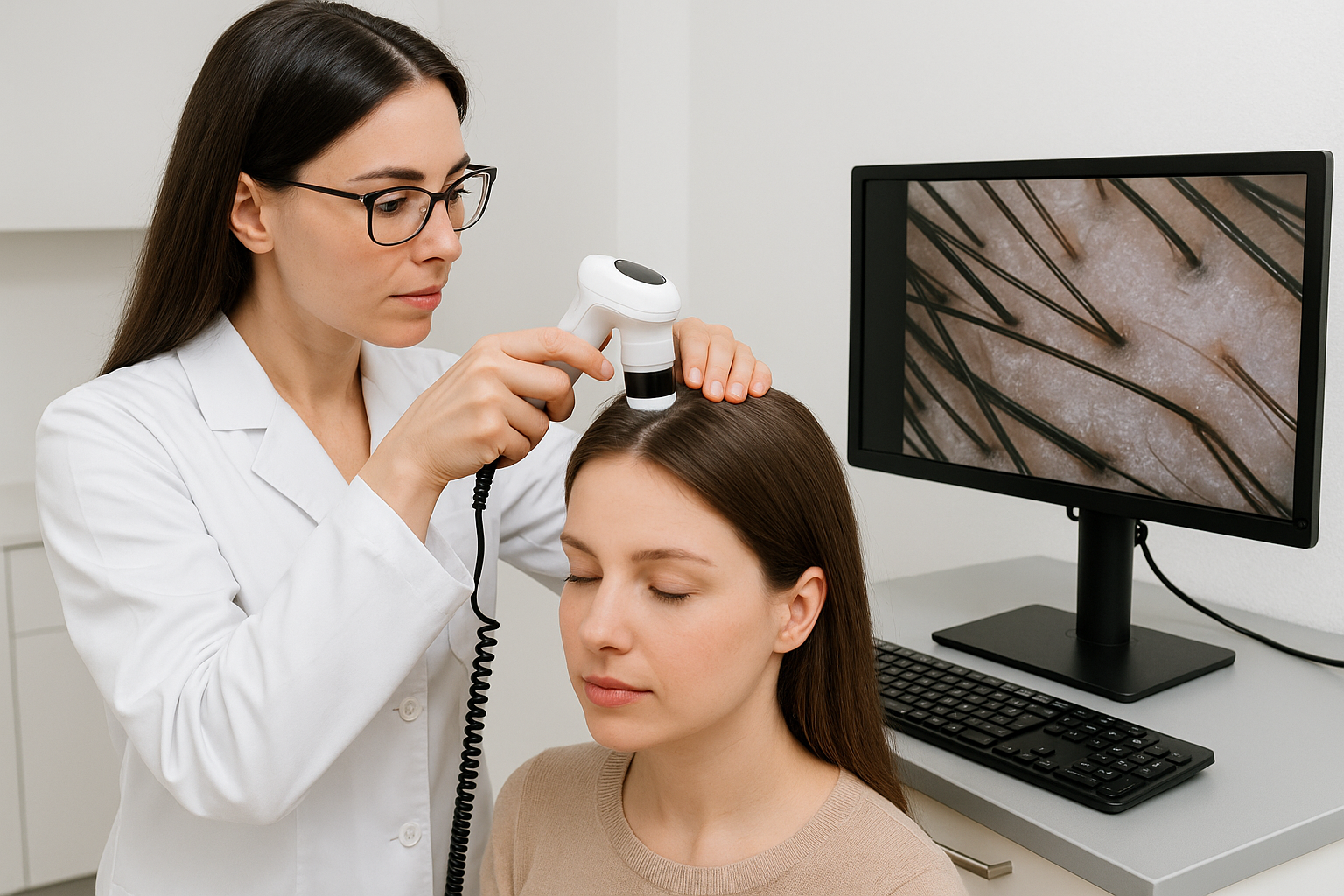
Treatment and Prevention Strategies
Effective hair loss management requires a comprehensive approach combining medical interventions with lifestyle modifications to address underlying causes and promote optimal hair growth. Evidence-based treatments range from FDA-approved medications to preventive strategies that support the natural hair cycle and minimize future damage.
Medical Treatments for Hair Thinning
Minoxidil represents the cornerstone of topical hair regrowth treatments, demonstrating significant efficacy in clinical trials where 64% of men experienced moderate to dense hair regrowth after 48 weeks of consistent application [8]. This FDA-approved vasodilator enhances blood flow to hair follicles, extending the anagen growth phase and increasing follicle diameter. Available in 2% and 5% concentrations, minoxidil requires continuous use to maintain benefits, with visible hair regrowth typically appearing after 3-4 months of regular application.
Finasteride offers an oral treatment option for male pattern baldness by inhibiting 5-alpha-reductase, the enzyme converting testosterone to dihydrotestosterone (DHT). Clinical studies show that finasteride prevents further hair loss in 83% of men and promotes new hair growth in 65% of participants over two years [9]. However, this medication requires careful consideration due to potential side effects and is not recommended for women of childbearing age.
Professional procedures complement topical treatments for comprehensive hair restoration. Platelet-rich plasma (PRP) therapy utilizes concentrated growth factors from the patient’s blood to stimulate follicular regeneration. Hair transplantation techniques, including follicular unit extraction (FUE) and follicular unit transplantation (FUT), provide permanent solutions for advanced hair loss by relocating healthy follicles to thinning areas.
Lifestyle and Prevention Approaches
Nutritional support forms the foundation of any effective hair care routine, as hair follicles require adequate protein, iron, biotin, and vitamins D and B12 for optimal function. A balanced diet rich in lean proteins, leafy greens, nuts, and fatty fish provides essential building blocks for healthy hair growth while supporting overall follicular health.
Stress management plays a crucial role in preventing telogen effluvium and diffuse thinning. Chronic stress elevates cortisol levels, disrupting the hair growth cycle and pushing follicles into premature resting phases. Regular exercise, meditation, and adequate sleep help maintain hormonal balance necessary for consistent hair growth.
Gentle hair care practices prevent mechanical damage that can exacerbate existing hair loss. Use wide-tooth combs on wet hair, avoid excessive heat styling, and choose sulfate-free shampoos that cleanse without stripping natural oils. Protective hairstyles minimize tension on follicles, while regular scalp massage improves circulation and may enhance treatment absorption.

Conclusion
Understanding the fundamental differences between hair thinning and hair shedding empowers you to respond appropriately to changes in your hair. While normal shedding represents a healthy part of your hair’s natural cycle, involving 50-100 strands daily, hair thinning indicates a more concerning pattern where follicles produce progressively weaker strands or stop producing hair entirely.
The key lies in recognizing when your hair loss exceeds normal parameters. Sudden increases in daily shedding, visible scalp areas, or progressive reduction in hair density warrant immediate attention. Early intervention significantly improves treatment outcomes, whether addressing temporary shedding triggers like stress or nutritional deficiencies, or managing genetic hair thinning conditions.
Don’t hesitate to consult your GP or a Specialist Hair Doctor when you notice persistent changes. Professional evaluation can distinguish between temporary shedding phases and progressive hair loss conditions, ensuring you receive appropriate treatment strategies. Remember that many effective solutions exist for both hair shedding disorders and hair thinning conditions, but their success often depends on timely implementation.
Taking proactive action early protects your hair’s future health while addressing legitimate concerns before they become more challenging to manage effectively.
Frequently Asked Questions
Normal hair shedding ranges from 50-100 hairs per day as part of the natural hair growth cycle. This number can vary based on hair density, age, and washing frequency.
Hair thinning from androgenetic alopecia can be slowed and sometimes reversed with early treatment using FDA-approved medications like minoxidil. Temporary thinning from stress or nutrition often recovers naturally.
Most hair loss treatments require 3-6 months of consistent use before noticeable improvements appear, as hair follicles need time to respond and grow new hair through complete growth cycles.
Male pattern hair loss typically shows receding hairlines and crown balding, while female pattern hair loss usually presents as diffuse thinning across the crown with maintained frontal hairline.
References
- Hoover E, Alhajj M, Flores JL. Physiology, Hair. StatPearls Publishing; 2023. PMID: 29763123
- Phillips TG, Slomiany WP, Allison R. Hair Loss: Common Causes and Treatment. Am Fam Physician. 2017;96(6):371-378. PMID: 28925637
- Rakowska A, Slowinska M, Olszewska M, Rudnicka L. New trichoscopy findings in trichotillomania: flame hairs, V-sign, hook hairs, hair powder, tulip hairs. Acta Derm Venereol. 2020;100(12):adv00149. PMID: 24096547
- Varothai S, Bergfeld WF. Androgenetic alopecia: an evidence-based treatment update. Am J Clin Dermatol. 2021;22(3):317-327. PMID: 24848508
- Grover C, Khurana A. Telogen effluvium. Indian Dermatol Online J. 2013;4(4):320-325. PMID: 23974577
- Lolli F, Pallotti F, Rossi A, et al. Androgenetic alopecia: a review. Endocrine. 2017;57(1):9-17. PMID: 28349362
- Heilmann-Heimbach S, Herold C, Hochfeld LM, et al. Meta-analysis identifies novel risk loci and yields systematic insights into the biology of male-pattern baldness. Nat Commun. 2017;8:14694. PMID: 28272467
- Olsen EA, Dunlap FE, Funicella T, et al. A randomized clinical trial of 5% topical minoxidil versus 2% topical minoxidil and placebo in the treatment of androgenetic alopecia in men. J Am Acad Dermatol. 1990;22(3):468-476. PMID: 17761356
- Kaufman KD, Olsen EA, Whiting D, et al. Finasteride in the treatment of men with androgenetic alopecia. Finasteride Male Pattern Hair Loss Study Group. J Am Acad Dermatol. 1998;39(4 Pt 1):578-589. PMID: 9777765

